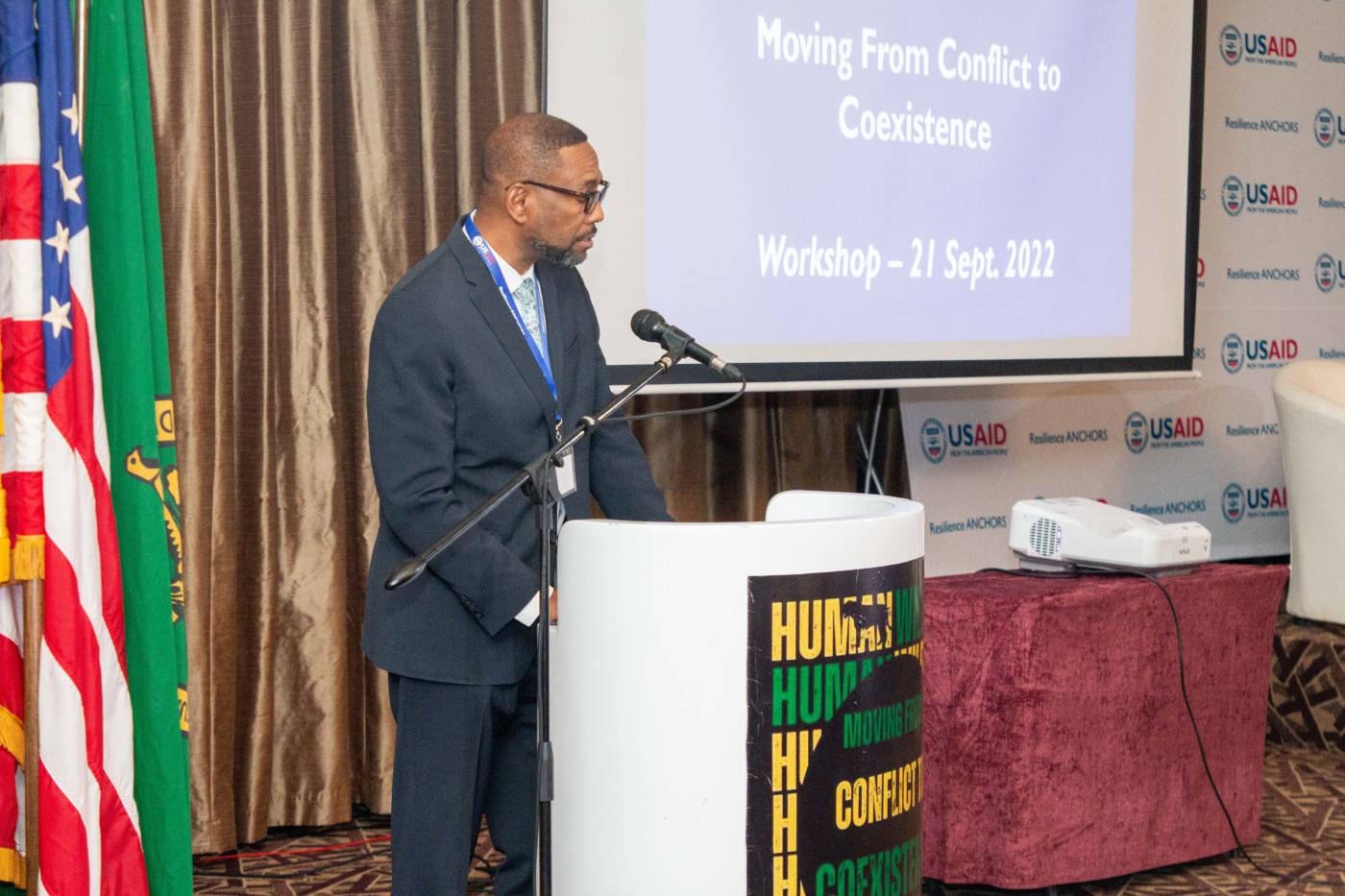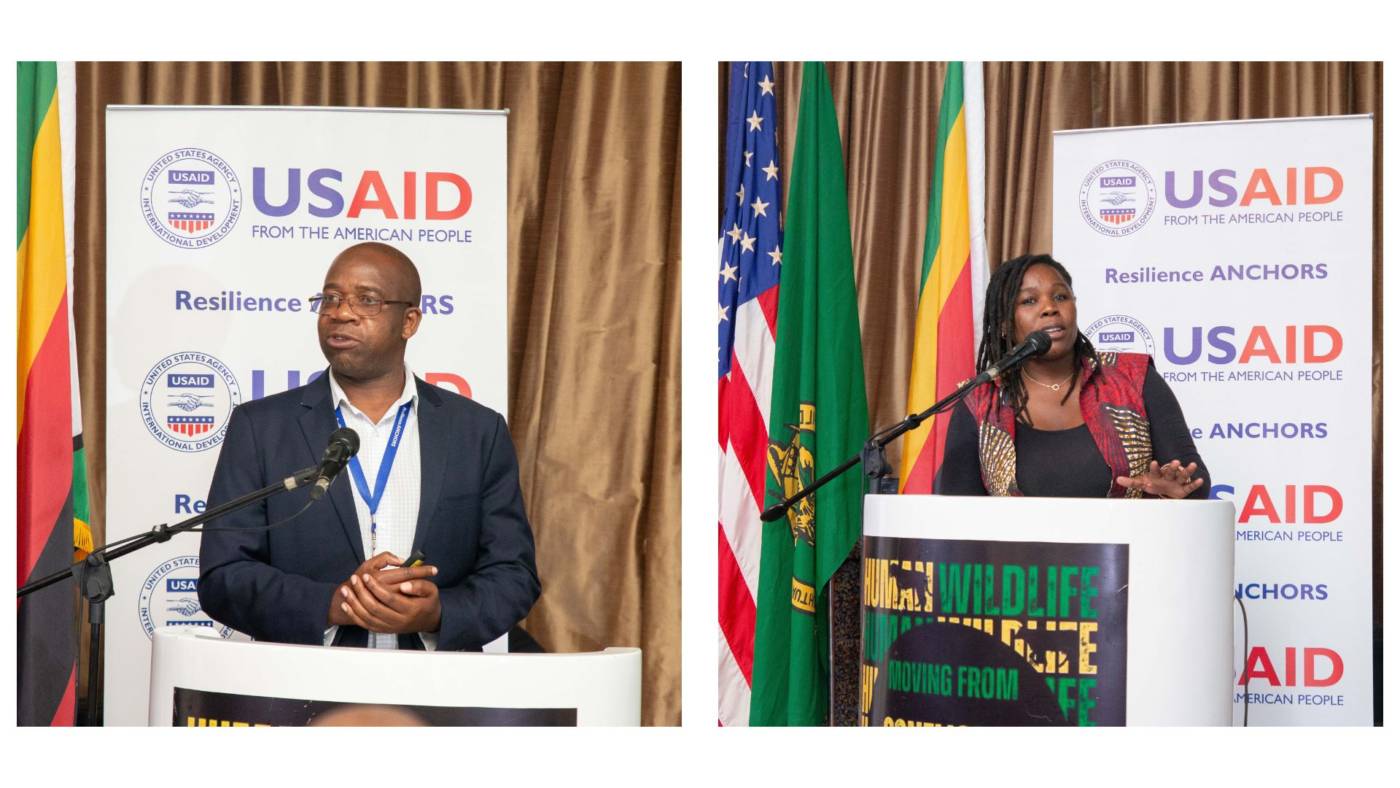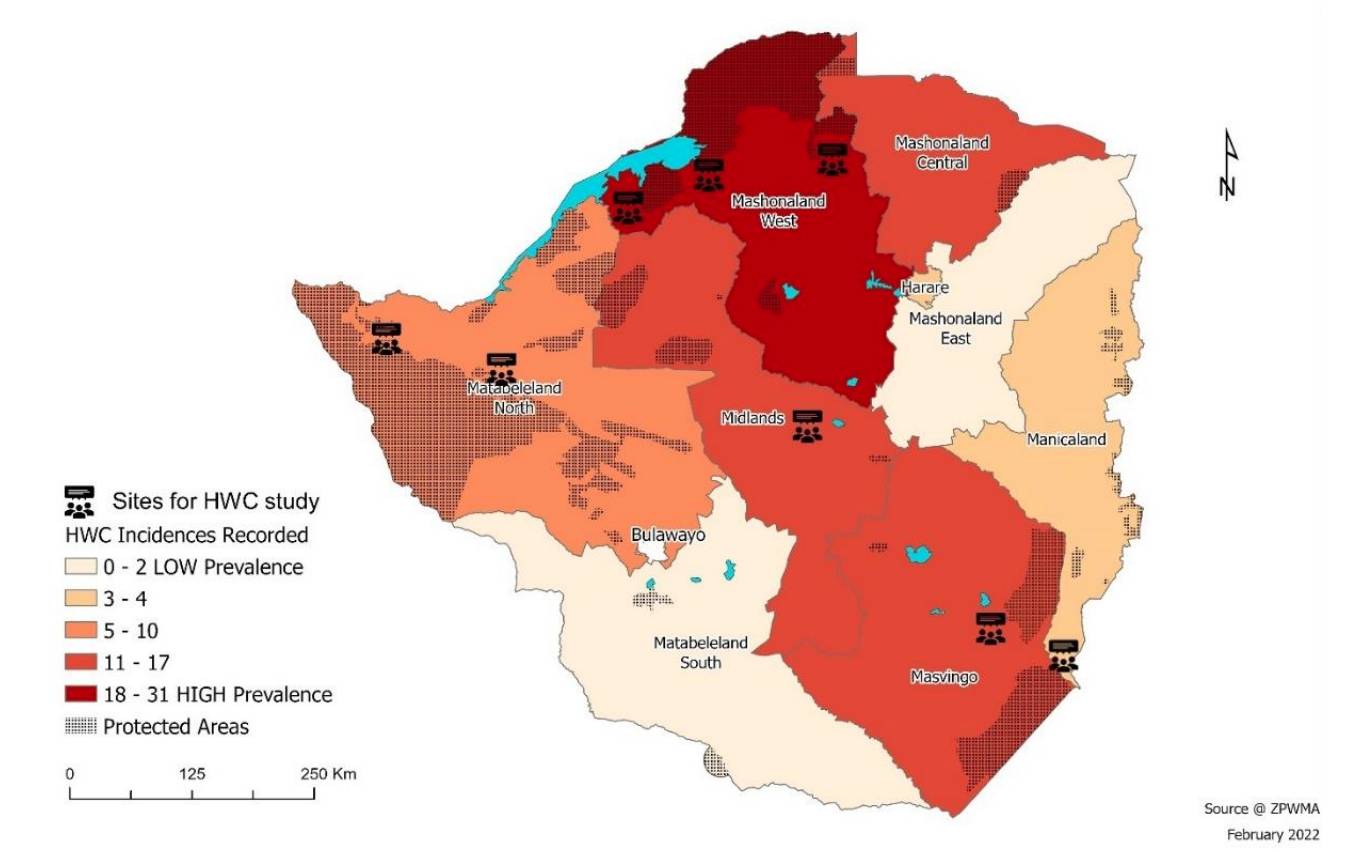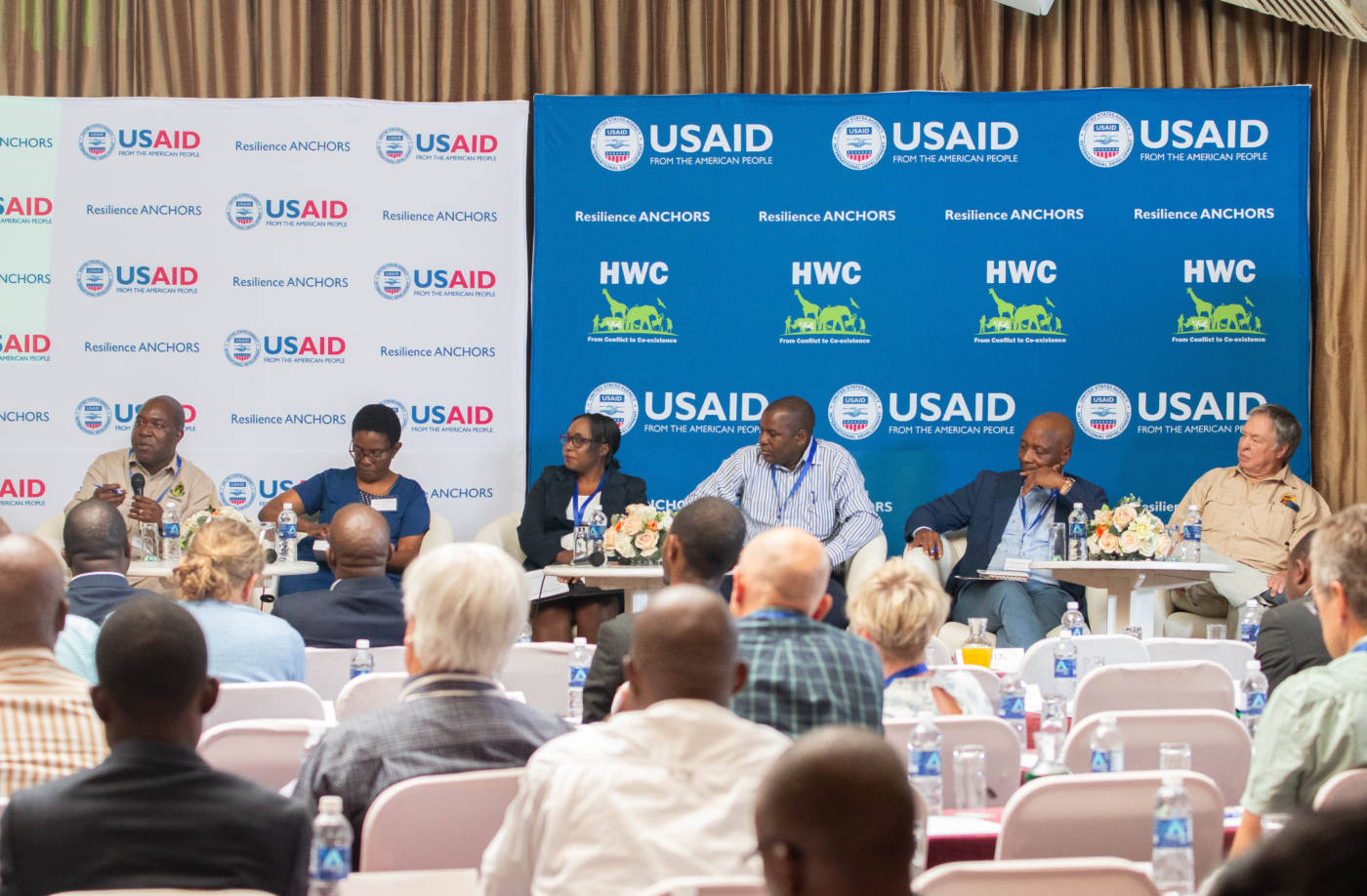USAID Resilience ANCHORS Activity brought together stakeholders from across the country to discuss the state of human-wildlife conflict in Zimbabwe, and how we can build resilient communities that can sustainably coexist with wildlife while benefitting from their surrounding natural resources.

Acting Mission Director of USAID, Mr Ramses Gauthier.
Last week on September 21st, the United States Agency for International Development (USAID) brought together over 150 stakeholders, including representatives from Zimbabwe Parks and Wildlife Management Authority (ZPWMA), other government agencies and various development and conservation organisations, to discuss one of the biggest conservation issues in the country and the wider continent today; human-wildlife conflict (HWC).
The workshop, which was hosted at Monomotapa Hotel in Harare, was a key action step as part of the HWC mitigation/coexistence activity under the USAID Resilience ANCHORS Activity. It is one of nine key interventions of the project, which aims to increase the capacity of communities to sustainably protect and manage their natural resources and the wildlife economy in order to mitigate future shocks and stresses.
The key objectives of the workshop were to:
- Share findings on the current state of human-wildlife conflict in Zimbabwe which was investigated via three research studies undertaken by the Resilience ANCHORS Activity on human-wildlife coexistence.
- Bring together stakeholders engaged with HWC to share and discuss their experiences and key mitigation techniques and strategies for coexistence.
- Foster dialogue and inspire collaboration and partnerships to achieve the shared goal of human wildlife coexistence, ensuring solutions are locally developed and managed.
The half-day symposium presented research, learnings and insights on HWC by several experts working within the conservation and livelihood development sectors. Their presentations prompted constructive dialogue as delegates were invited to ask questions, with some key questions and themes being further unpacked and debated by a panel of experts at the end of the workshop.
Delegates were welcomed by honorary guest, ZPWMA Director General, Dr Fulton Mangwanya, who offered his support for the multi-stakeholder gathering on the important issue of HWC, which is currently one of the primary threats to protected wildlife areas and surrounding communities. His welcome address was followed by Acting Mission Director of USAID, Mr Ramses Gauthier, who gave the opening remarks for the workshop.
The workshop kicked off with three presentations (policy framework and findings and recommendations) from Mr Mutuso Dhilwayo (CEO) and Dr Byron Zamasiya from the Zimbabwe Environmental Law Association (ZELA), as well as Dr Moreangels Mbizah from Wildlife Conservation Action (WCA). The organisations were commissioned by USAID Resilience ANCHORS to conduct a national study. The aim of the research was to provide stakeholders with detailed information on the status, nature and dynamics of human-wildlife conflict, and to better understand how communities experience HWC, and in what ways they are affected by it. The research covered Chipinge, Chiredzi, Kwekwe district, Hwange, Victoria Falls urban, Kariba urban, Mbire and Nyaminyami.

(Left) Research presented by Mr Mutuso Dhilwayo, CEO of ZELA, verified that HWC is certainly a fast-increasing threat, with a 293% increase in problem animal reports from 2016 to 2021 (ZPWMA, 2021). (Right) Dr Moreangels Mbizah presented local and national mitigation strategies which highlighted the need for a holistic approach to achieve human-wildlife coexistence.
The presenters shared the objectives of the research; a comprehensive understanding of the problem; the history of HWC and associated legal frameworks and policies; findings regarding the nature and scale of the HWC; dynamics, key factors and causes; affected areas and prevalence; implications and consequences; and concluded with a host of valuable recommendations. Ms Mbizah presented local- and national-level mitigation strategies and highlighted the need for a multi-pronged, holistic approach that considered social dynamics, human aspirations, land development, conservation plan, local socio-cultural needs and factors and drivers of conflict.
The findings from the three research projects will inform the design and implementation of a suite of strategies and interventions to be implemented by ZPWMA, Resilience ANCHORS and other actors engaged with and/or working on HWC. The findings will also feed into ongoing national legal and policy reforms that include review of the Parks and Wildlife Act and possible drafting of a new Wildlife Policy for Zimbabwe.

Figure 1. Location of the eight study sites across the human-wildlife conflict hotspots in Zimbabwe.
The research presentations were followed by a moving video by USAID Resilience ANCHORS, which captured testimonials of numerous HWC victims across the country. The hard-hitting video highlighted the realities and unfathomable loss of life, health and livelihood that is experienced by rural communities in wildlife areas on a daily basis, reminding attendees of our shared plight to find solutions, systems and policies that will enable communities to not only coexist with wild animals, but also benefit from their surrounding natural resources.
The second part of the workshop focused on HWC mitigation efforts, which were highlighted through insightful presentations by Dr Peter Lindsey of the Lion Recovery Fund, who gave the regional perspective on carnivores; Mr Malvern Karidozo from Connected Conservation who offered the Zimbabwe and KAZA perspective with a focus on elephants; and Dr Rob Cunliffe from Gonarezhou Conservation Trust, which offered the ZPWMA perspective. Dr Lindsey shared some HWC mitigation strategies from across Africa, talking about the effectiveness of ‘Lion Guardians’ and the importance of inclusive land-use planning, where communities are the beneficiaries. He closed by encouraging delegates that “human-wildlife coexistence is possible, with real effort and resources”, reiterating that some initiatives are proving to be successful in other parts of Africa.

“Human-wildlife coexistence is possible, with real effort and resources”, said Dr Peter Lyndsey from Lion Recovery Fund.
Delegates were then treated to the premier launch of an upcoming short film called “Konflikt” – a story about human-wildlife conflict based on true events. Directed by Mr Sydney Taivavashe, the film is currently self-funded and is looking for financial support to assist in the final production and launch. It hopes to raise international awareness of HWC issues, while also reaching the communities which are affected by wildlife conflict.
A presentation and discussion were subsequently led by Dr Edson Gandiwa, Director of Scientific Services, ZPWMA, who gave an update on CAMPFIRE, reiterating CAMPFIRE’s objectives and explaining that the previous review of 2016-2018, which was supported by the European Union, was being updated based on recommendations that are aligned to legal and policy reforms on CBNRM (community based natural resource management), and would be implemented with the support of a statutory instrument. Amongst a list of relevant factors, the review considers community rights, community participation and human wildlife conflicts, access and benefit sharing as well as the devolution of management and authority with the assignment of appropriate authority (AA) for natural resource management at local level.
The workshop was closed by a discussion panel moderated by Dr Mathew Mbanga (Foundations for Farming) who led discussions with the following experts: Professor Edson Gandiwa; Professor Prisca Mugabe (Deputy Dean, Faculty of Agriculture, Environment and Food Systems, University of Zimbabwe); Ms Courage Muzemberwa Mbiriyawanda (Senior Environment Officer, Ministry of Environment, Climate, Tourism and Hospitality Industry); Clr. Elmon Mudenda (Deputy Director, CAMPFIRE Community Producers Association, Mucheni Community Conservancy Representative, Councilor Ward 4, Binga); Dr. Emmanuel Fundira (Chairman, Safari Operators Association Zimbabwe (SOAZ), Board member, African Sun Hotels & Resorts (ZSE Listed)); and Mike La Grange (Director, African Wildlife and Conservation Management (AWCM)).
During the panel discussion some of the key questions, themes and points raised during the conference were addressed by the experts. One important point was the topic of compensation, which was also a key recommendation of the research conducted by ZELA. Ms Courage Mbiriyawanda confirmed that the government is indeed planning for a national compensation policy. Compensation was however, only one of many strategies that delegates agreed would be needed in the move towards successful models of human-wildlife coexistence, which was agreed should be multi-species focused and multi-pronged.
Dr Emmanuel Fundira made the hard-hitting point that we cannot think about mitigation without addressing one of the root causes of HWC – historical non-inclusive land use planning. He said that participatory land use planning is essential if we are to tackle HWC.

Expert panel from left to right: Dr Edson Gandiwa, Professor Prisca Mugabe, Ms Courage Mbiriyawanda, Clr. Elmon Mudenda, Dr. Emmanuel Fundira, Mike La Grange.
Throughout the workshop, one of the recurring themes and underlying issues highlighted was that, generally speaking, communities felt that protection of wildlife is prioritised over their own livelihoods and wellbeing, while they suffer from injury and loss of life, and major loss of livelihoods through crop and livestock loss and debt.
There was consensus that HWC needs to now be seen and tackled through a human rights lens, with local and national policies and frameworks that support people living in and adjacent to wildlife areas, ensuring that they not only understand, but also benefit from the economic value of the protected biodiversity and natural resources. Increased education and awareness, a compensation scheme and CAMPFIRE revitalisation, are some of the agreed strategies towards a holistic model of human-wildlife coexistence.
With the growing threat of climate change and other shocks, it has become clear that HWC has become a matter of urgency, and that stakeholders need to understand the causes and driving factors in order to come together to formulate and implement appropriate, sustainable solutions. Dr Mathew Mbanga closed the session by encouraging us to stick to all the ‘C’s’ – collaboration, communication, creativity, commitment, compassion and courage in our plight to achieve coexistence.
The workshop closed with a media conference and briefing.
In order to reduce human-wildlife conflict, we must reassess the relationship—and especially the direct interactions—between people and wildlife to improve our future coexistence. We must adopt approaches that identify and address the deeper, underlying causes of conflict while developing systematic, context-specific solutions with affected communities as active and equal participants – Resilience ANCHORS Activity.
Written by Jaeninne Norris
Further reading: Background: Summary of the Resilience Anchors Project overview of HWC
Human-wildlife conflict (HWC) is defined as the negative interactions between humans and wild animals, which has undesirable consequences for people and their livelihoods on the one hand and wild animals and their habitats on the other.
The successful conservation of wildlife and the well-being of communities living adjacent to protected areas largely depends on the extent to which the communities and wildlife themselves can co-exist. Human-wildlife conflict is one of the major shocks or challenges experienced by communities living adjacent to wildlife areas across the country. Developing solutions for HWC has therefore become an urgent conservation priority in human dominated wildlife landscapes.
HWC is as much a development and humanitarian issue as it is a conservation concern, where the costs of living with wildlife are unevenly distributed and often disproportionately affect low-income communities living below the poverty line, mainly impacting farmers, herders, and artisanal fishers. At an international level, HWC affects the production of agricultural goods and the global supply chain, leading to decreased producer productivity and food insecurity.
Human-wildlife coexistence is a dynamic but sustainable state in which humans and wildlife co-adapt to living in shared landscapes. It is whereby human interactions with wildlife are governed by effective institutions that ensure long-term wildlife population growth, social acceptance, and tolerable levels of risk. As demonstrated in many case studies, coexistence is both possible and attainable.

